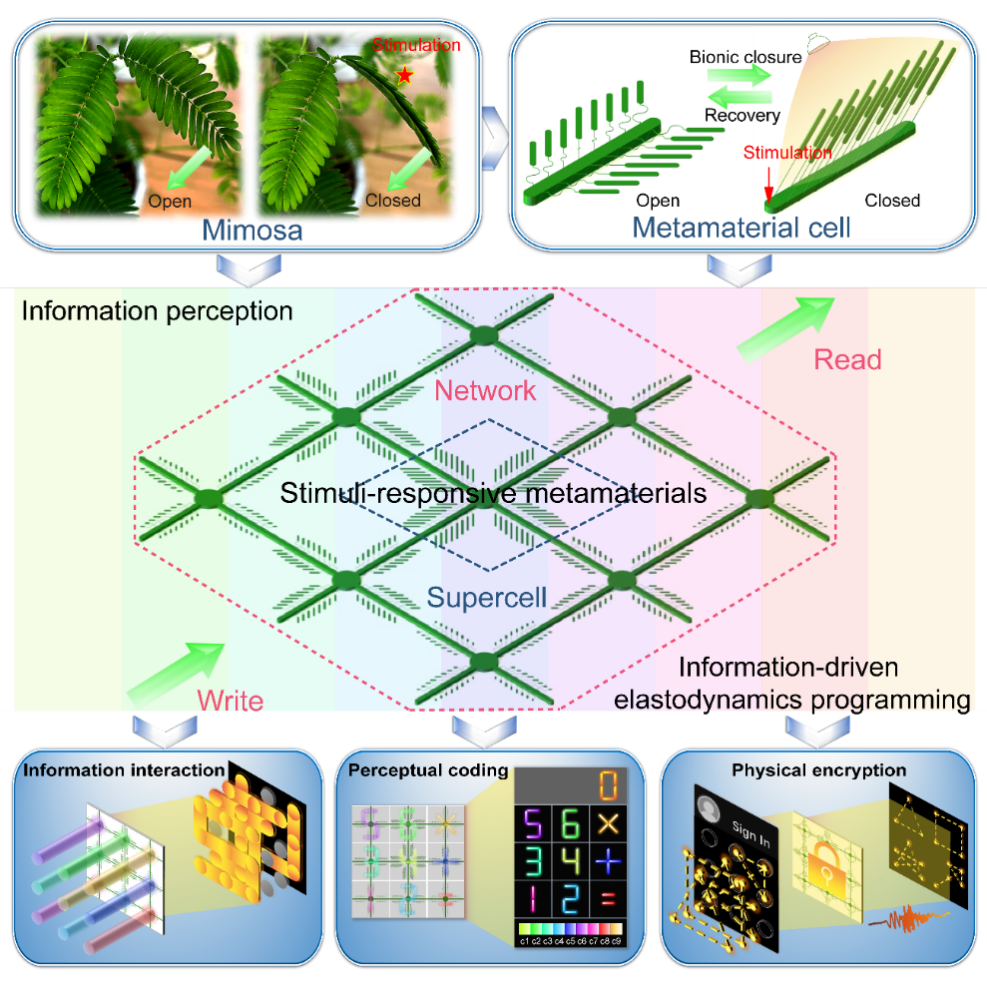
News

News
Recently, Professor Qingbo He and Professor Zhike Peng from the State Key Laboratory of Mechanical Systems and Vibration published a research article titled "Stimuli-responsive metamaterials with information-driven elastodynamics programming" in the Matter of Cell Press Journals, which first proposed a concept of information-driven elastodynamics programming, and created a new way to perceive information through structural vibration. The first author of the paper is doctoral student Li Chong, and the corresponding authors are Professor Zhike Peng and Professor Qingbo He.

The biological stimuli-responsiveness is the ability to exhibit adaptive functional responses to external environmental stimuli, which is widespread in nature, such as the closure of mimosa leaves when touched, the snapping of Drosera capensis L., the opening-closing of pinecones and the twisting-untwisting of seedpods. This fascinating biological intelligence inspires a lot of researches on material-based functional systems, which has broad prospects in various fields including multifunctional sensing, flexible actuating, physiology monitoring and 4D printing. Currently, the stimuli-responsive materials are explored as building blocks to construct bioinspired material-based systems, which have important implications to release smart devices from complex hardware. Stimuli-responsive materials are capable of changing their physical or chemical properties (e.g., shape, color or hardness) in response to external stimuli. Traditional works are still limited programmable elastostatics property to achieve functional morphological changes. To date, it remains challenging to achieve the adaptive elastodynamics programming in design of stimuli-responsive metamaterial systems, which is very important for exploring material-based intelligent systems.

Stimuli-responsive metamaterials with information-driven elastodynamics programming
To address this challenge, this work proposes a stimuli-responsive elastic metamaterial with information-driven elastodynamics programming as a potential solution. The concept of information-driven elastodynamics programming in metamaterials is to program the stimulation information into the elastodynamics properties of stimuli-responsive metamaterials. The proposed metamaterials consist of shape-morphing resonators whose local resonance state changes from disorder to order upon elusive stimuli by mimicking the autonomous closure of Mimosa pudica leaves. Researchers design the metamaterial cells by developing the adaptive disorder-order resonance transition mechanism. Imitating the mimosa growth, researchers further configure nine-size supercells as the nodes to build a metamaterial network. Upon external stimuli, the state transition of local resonance is programmed into the global dynamical response of the network adaptively, and the information-driven elastodynamics programming is thus realized.
This article demonstrates that the designed metamaterial network exhibits a mechanical implementation of read-write operations, leading to a bionic proprioception of stimulation information with potential applications in information interaction, perceptual coding and physical encryption. The rationally designed metamaterials achieve the information-driven elastodynamics programming that has not been attainable in conventional stimuli-responsive material systems, thus opening new opportunities for material-based smart systems. This work may have a broad impact in design of various devices with material-based proprioception for sensing, computation and communication.
This work was supported by the National Natural Science Foundation of China (Grant No: 11872244 and 12121002) and the National Program for Support of Top-Notch Young Professionals. In recent years, Professor Qingbo He has carried out cutting-edge research on endowing intelligence to structures in the field of dynamic monitoring and fault diagnosis of mechanical equipments, and has achieved innovative results in elastic wave coding perception technology.
Paper Link: https://doi.org/10.1016/j.matt.2021.11.031
Source: Institute of Vibration, Shock & Noise

Shanghai Jiao Tong University
Address: 800 Dongchuan Road, Shanghai
200240